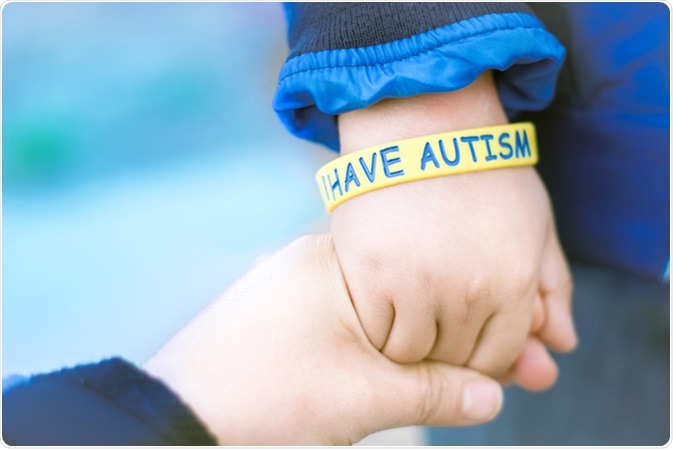Autism spectrum disorders (ASD) are a group of neurodevelopmental disorders characterised by impaired social interactions and communications in different settings/multiple contexts.
In addition to classical symptoms such as behavioural disturbances, delay in learning to speak, inappropriate social interaction, obsession over particular objects or foods, lack of eye contact, and language comprehension issues, there may also be sleep disturbances in ASD. This article will explore the link between autism and sleep disturbances.

Image Credit: Zahraa Saleh / Shutterstock
How Common Are Sleep Disorders in Autism?
Sleep problems are more common in children with ASD compared to those without, with studies showing prevalence ranging from 40-80% (~55% on average) of all autistic children.
These sleep disorders are characterised by insomnia: difficulty in falling asleep, early morning awakening, bedtime resistance issues, and daytime sleepiness. More than 75% of all autistic children may suffer from sleep disorders on a daily basis. It is therefore evident from several studies that sleep issues are incredibly common in ASD children, which may persist into adulthood.
Often, as a consequence, the daytime behaviour of ASD children with sleep disturbances is significantly worse, as reported by parents. Other studies have shown that insomnia in ASD correlates with social skills deficits, as well as increased overall autism scoring. Therefore, combatting sleeplessness in ASD may be important to the overall health of ASD children.
What Causes Sleep Disturbances in Autism?
The sleep disturbances in autism may be attributed to the complex interplay between the genetic, physiological, neurological, psychological and environmental factors (including family factors), without a single causative factor.
The hypothalamic-pituitary-adrenal (HPA) axis is involved in the regulation of our circadian rhythms (sleep-wake cycle). In ASD, this particular axis may be abnormal leading to decreased melatonin production – the hormone that induces sleep.
As part of the HPA-axis, the pre-optic area of the hypothalamus is especially important in the promotion of sleep. This particular area is extensively GABA-ergic (uses GABA as a neurotransmitter). GABA is the main inhibitory neurotransmitter within the brain, and usually inhibits parts of the brainstem (such as the pedunculopontine and laterodorsal tegmental nuclei, as well as the locus coeruleus) involved in arousal, therefore allowing sleep to occur.
Studies have shown that through development, children with ASD have impaired GABA-ergic neuronal migration and maturation. Therefore, in ASD, the normal levels of inhibition by GABA to key brainstem regions may not occur to the same extent, subsequently leading to reduced arousal levels as a result of dysfunction of the HPA-axis-brainstem circuitry.
Several studies have also shown impaired melatonin homeostasis in children with ASD, with significantly reduced night-time melatonin levels. Furthermore, the degree of melatonin dysregulation seems to correlate with the severity of ASD symptoms. This has been linked to mutations to the ASMT gene (found on the sex chromosomes). ASMT encodes an enzyme also known as ASMT which is involved in the final step of the melatonin biosynthesis pathway. Since this gene is deleted in several forms of ASD, it would cause an overall reduction in melatonin levels, therefore impairing the circadian rhythm in ASD children affecting their ability to sleep and stay asleep.
Children with ASD often have comorbid psychiatric conditions such as anxiety, mood, or attention-deficit/hyperactivity disorders, which can all negatively influence sleep. Hormonal dysregulation (such as through the HPA-axis and serum cortisol levels in stress) from the underlying disorder as well as medications can impact sleep. It is therefore important to source the cause of the sleep disturbances before deciding on the correct behavioural or pharmacological intervention.
How to Improve Sleep in Children with Autism?
After proper evaluation of the causes of sleep issues in ASD children and dismissing physiological causes for insomnia such as seizures or sleep apnoea, as well as environmental considerations such as bedding and temperature, behavioural interventions can be put in place to help modify bedtime routine.
Establishing a proper bedtime routine that is consistent on a daily basis may help some ASD children, to ensure there are positive sleep patterns formed. For example, setting an appropriate bedtime that is reminded often for the child and the family may reinforce positively and help prepare mentally for bedtime.
It is also important to make sure that environmental cues that could be influencing sleep are also dealt with. ASD children can be hypersensitive to certain sounds and textures. Therefore, trialling the most suitable pyjama/bedding texture and weight may be a good start. Eliminating outdoor noises may also be important if they confound the sleep routine. It has also been reported that continuous soothing sounds such as white noise can be effective in inducing calmness and sleep in some ASD children.
If behavioural changes do not result in any positive improvements to a child’s sleep, medications such as clonidine (alpha-2 adrenergic agonist) may be prescribed, as it is has been shown to reduce the time to sleep and frequency of awakenings. More promisingly, melatonin supplementation (3-6mg) has also been shown to have a lasting positive effect on sleep in children with ASD through modulation of the HPA-axis and serotonin pathways within the CNS, especially those with the ASMT mutation.
Further Reading